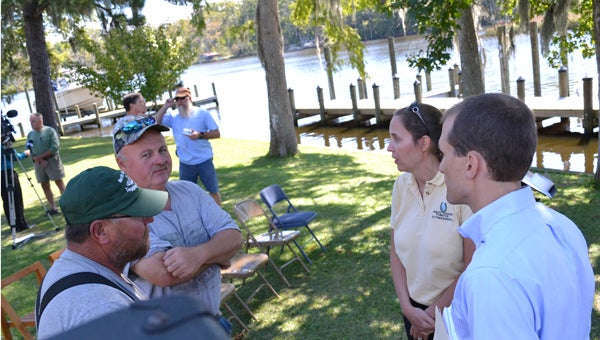PTRF takes mine battle to the courts
Published 7:54 pm Thursday, September 19, 2013

VAIL STEWART RUMLEY | DAILY NEWS
STATE POLICED: Fishermen David Massengill and David Latham speak with Pamlico-Tar River Foundation riverkeeper Heather Jacobs Deck, and Southern Environmental Law Center attorney Geoff Gisler, Thursday after PTRF, SELC and the North Carolina Coastal Federation announced the organization’s had filed a challenge to a NPDES permit issued by the state to Martin Marietta Materials, Inc. in July.
Pamlico-Tar River Foundation joined forces with the North Carolina Coastal Federation and the Southern Environmental Law Center to challenge a state-issued permit they say violates the Clean Water Act.
“By issuing this permit, the state violated the core requirement of the Clean Water Act: to protect our waters — and the numerous benefits they provide — as they exist naturally,” wrote SELC staff attorney Geoff Gisler in a press release.
In July, Division of Water Quality issued the National Pollution Discharge Elimination System (NPDES) permit to Martin Marietta Materials, Inc. for the company’s 649-acre open pit aggregate mine to be located in southern Beaufort County. The permit authorizes Martin Marietta to discharge 12 million gallons of mine wastewater in the headwaters of Blounts Creek per day. But that amount of freshwater flowing into a designated swamp area will substantially change the pH of water and the aquatic life depending on it — and break state law in the process, according to the petition filed with the Office of Administrative Hearings in Raleigh.
The objections to the permit were cited as follows: the discharge will violate state water quality standards because it will negatively affect Blounts Creek’s biological integrity; it will dramatically change Blounts Creek’s pH; and it will negate Blounts Creek’s classification as swamp waters, which are protected by the state for secondary recreation — wading, boating, fishing and fish consumption, wildlife habitat, aquatic life and agriculture.
“If this permit is allowed to stand, the swamp waters will no longer be swamp waters,” Gisler said at a joint PTRF/SELC press conference Thursday at Cotton Patch Marina on Blounts Creek. Several dozen people who continue to voice their concerns over the proposed mining operations turned out for the announcement. Primary among those concerns is the potential change of the water’s pH from a range of 4.0 to 5.5, as measured upstream from Blounts Creek tributary Herring Run, to a predicted 6.3 to 6.9. According to the petition, low pH, along with high salinity and the slow-moving nature of the creek, make for a valuable habitat for fish species that use brackish waters: striped bass, blueback herring, American shad, southern Flounder and spotted seatrout, among them.
The potential threat to Blounts Creek’s natural habitat brought fishermen David Massengill and David Latham to the press conference. Both men have campers at the Campground on Blounts Creek; both spend much of their spare time fishing area waters.
“If they ruin the creek, I might was well not come down here,” Latham said. “Without the creek, this spot is void.”
Pamlico-Tar River Foundation’s riverkeeper, Heather Jacobs Deck, said her organization, and its members, are committed to the PTRF mission — to preserve, protect and promote the environmental quality of the Tar-Pamlico and its watershed — and don’t take a legal challenge to NPDES permit lightly. The hope is not to stop the mine, but to motivate Martin Marietta to explore other discharge options available to the company.
“There are other alternatives. This does not have to happen,” Deck said.
However, filing the petition does not stop Martin Marietta from moving forward with its plans to build the mine, Gisler explained. The petition will be heard first by a judge within the Office of Administrative Hearings. If that judge decides the petition has merit, it could wind its way all the way up to the North Carolina Supreme Court.
“The state will defend its decision and Martin Marietta will very strongly defend their position,” Gisler explained. “But we’ll push forward and do our best to make sure the law is applied properly.“
Gisler said it would be approximately 45 days before a judge reviews the case. Until then, supporters are planning ways to raise money to help offset the cost of litigation. According to Blounts Creek resident Bob Boulden, a 5k race is in the works for October and a donation jar has been set up at Cotton Patch Marina.
“We’re not done,” Boulden said. “Even if they get the permit, we’re not done.”





